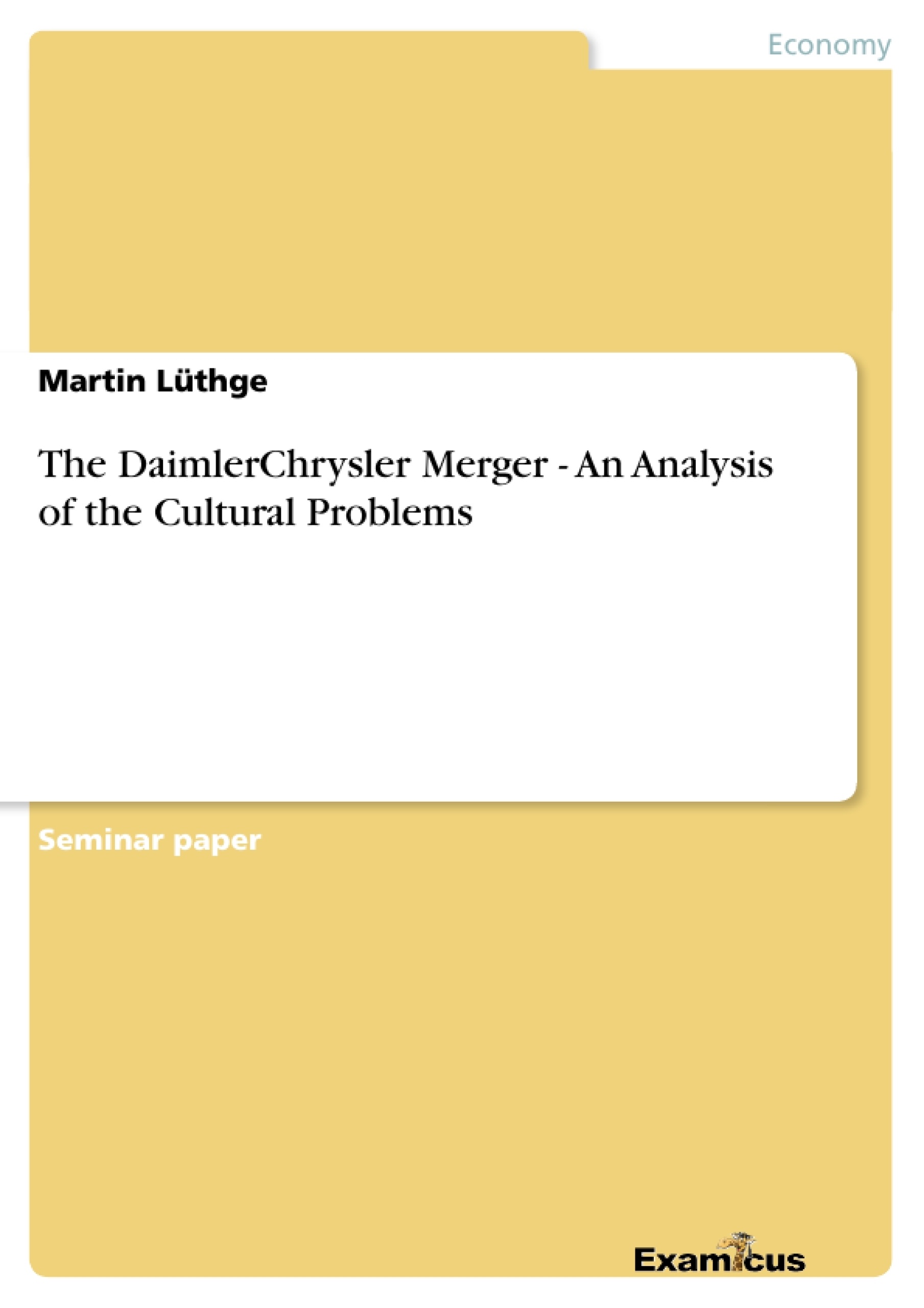Excerpt
Page 1

7KH'DLPOHU&KU\VOHU0HUJHU
&RXUVHRI$FWLRQ
Page 2
Page 2
,QWURGXFWLRQ)RUPLQJWKH:RUOG V7KLUGODUJHVW$XWRPRWLYH&RPSDQ\
On 6 May 1998, Daimler-Benz of Germany signed a merger agreement with Chrysler Corporation of the United States (Kuehlmann, T. & Dowling P. J., 2001). The merger marked the beginning of the ambitious goal of merging two styles of auto-making, two approaches to business and the proud, but distinct cultures of two nations (Wendell H. & Frantz P. L. & Geringer M. & Minor M., 2002).
The opportunities for significant synergies afforded by a combination based on factors such as shared technologies, distribution, purchasing and know-how. Daimler’s engineering skill and technological advances could be complemented by Chrysler’s skills for innovation, speed in 1 Juergen Schrempp, CEO of DaimlerChrysler, product development and bold marketing style.
said, that the new company will reach an eminent strategic position in the global marketplace by combining and utilizing each other’s strengths %ODßVNR 0 1HWWHU - 0 6LQNH\ - ) 2000).
It seems that Germans and Americans in the enterprise have not become closer since the merger. DaimlerChrysler employs not 420,000 people, but two employs, the German and the 2 This paper analyze which strategic failures were made by the merger in terms of American.
cultural issues and gives some recommendations to remedy the cultural problems.
&XOWXUDO'LIIHUHQFHVEHWZHHQ$PHULFDQVDQG*HUPDQV
The Hofstede model shows significant differences between Americans and Germans regarding FROOHFWLYLVPYVLQGLYLGXDOLVP and XQFHUWDLQW\DYRLGDQFH The USA rated much higher regarding the UHODWLRQVKLS GLPHQVLRQ than Germany as shown in Table 1. Germany’s lower score means a lower emphasis on co-operation (Hofstede, G., 1980). Indeed, it did not take long for the Americans to complain that the Germans wouldn' t listen and would only take orders from 3 Regarding XQFHUWDLQW\ DYRLGDQFH Germany received a consid- headquarters in Germany.
erably higher rating than the USA as shown in Table 1, which means that Germans feel much more threatened by XQFHUWDLQW\ DQG DPELJXLW\ (Hofstede, G., 1980). Americans are more accustomed living with uncertainties. Americans are used to lose their jobs, for instance (Ha- beck, M. M. & Kroeger, F. & Traem , M., 2002: 105). Germans try to DYRLG XQFHUWDLQWLHV
Page 3
among other things, by intensive analysis and planning and it is not unusual that Germans 4 need to make decisions from the view of Americans.
Another survey was conducted by Trompenaars, which shown in Table 2, that the IXWXUH has a higher importance for Amercians than Germans. Regarding the rating on QHXWUDOLW\ YV HPRWLRQDOLVP it is expressed that Germans are stiffer and do not express their feelings as intensive as Americans. Chrysler’s employees also experienced these behavior by Daimler’s 5 The analysis also shows that there are significant differences referring to themployees.
dimenension DFKLHYHPHQWYVDVFULSWLRQbetween Germans and Americans (Trompenaars F. & Hampden-Turner C. M., 1999).
,PSRUWDQFHRI&RUSRUDWH&XOWXUHDQG&RPPXQLFDWLRQDFURVV&XOWXUHV
Corporate culture of a company consists of cultural symbols, shared behaviors, cultural values, and shared assumptions as shown in Figure 1 (Hellriegel, D. & Slocum, J. W. & Woodman, R. W. 2001:513).
Differences in corporate culture, compensation policies, ownership structure, and the legal environment pose significant challenges to all mergers but especially international business combinations. In order to achieve goals with partners from different cultures, one has to recognize and soundly consider both cultural systems, so that the set objectives can be achieved (Krysteck, & Zur, 2002:264). The key issue is how these components of a cultural system affect conducting business. If their cultures are different then their business practices may also differ.
Behaviors such as stereotyping, prejudice and harassment could increase the barriers of communication between people from different cultures and subcultures. Often, this results in emotional distress, reduced performance and trans-national negotiations and business operations can be fraught with conflicts (Guirdham M., 1999:189).
7KH&XOWXUDO6WUDWHJ\IRUWKH0HUJHU
The objective of Mercedes-Benz was to develop an integrative culture for DaimlerChrysler by combining and utilizing each other’s strengths (Habeck et al., 2002: 109-113).
Page 4
The Germans saw a typical American company in Chrysler, with a complementary culture — 6 daring, diverse, and creative which was exactly what the Germans wanted.
Eaton and Schrempp emphasized the evolutionary process of an integration of both companies. Although the combination of Daimler-Benz and Chrysler was designed as a merger of equals, Daimler-Benz has been the more-equal partner and is imposing its own corporate im- SULQWRQWKHPHUJHGFRPSDQ\%ODßVNR0HWDO5HJDUGLQJ.U\VWHFk’s, U.& Zur’s, E. (2002:786-787) types of acculturation, especially in the post-merger integration, the fundamental cultural strategy looks more like an assimilation of Chrysler’s culture as shown in Figure 2. This impression is also supported by reports from internal parties and external analysts as mentioned later in the analysis of the merger process. If the German management of DaimlerChrysler follows up this strategy without any adjustments, there is also the risk tending to segregation or deculturation.
$FFRPSOLVKPHQWRIWKH0HUJHU
3KDVH7DUJHWLQJ
DaimlerChrylser set up a post-merger-integration team, which analyzed failed mergers of other companies. They found out that cultural problems were one of the essential reasons for failure (Habeck 2002: 113). Beyond this, an integrated merger & acquisition concept should determine by which characteristics the corporate cultures of the companies, which come into question, should be judged. The origins of the corporate cultures should be found. Furthermore, the characteristic and importances as shown in Figure 3 as well as the anchorage degrees should be analyzed. Afterwards the strategic ability of the cultures should be analyzed. The next step is to determine to what extent the existing business strategies will be promoted or obstructed by the corporate culture of the prospective companies. On the basis of this analysis the desired corporate culture should be developed Clever H. (1993) (Sauermann, S., 2000:135-136).
3KDVH1HJRWLDWLQJ
The cultural problems already started at the negotiation stage of the merger. Only one of Chrysler’s managers could speak German, but every manager of Daimler spoke English. In addition, most of Daimler’s executives were familiar with the US corporate law. Chrysler’s managers only had a smattering knowledge about the legal situation if the company would be
Page 5
7 At the beginning, the board of directors was filled in equal parts, but located in Germany.
several top Chrysler executives and engineers departed a short time later due to differences in FXOWXUHDQGFRPSHQVDWLRQ%ODßVNR0
- Quote paper
- Martin Lüthge (Author), 2003, The DaimlerChrysler Merger - An Analysis of the Cultural Problems, Munich, GRIN Verlag, https://www.grin.com/document/185902
Publish now - it's free






















Comments